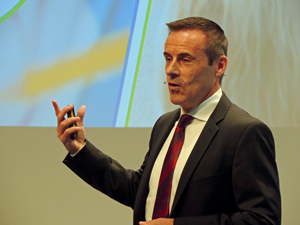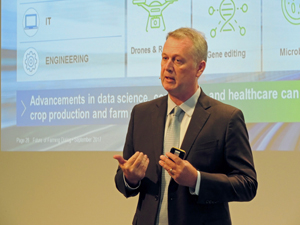MONHEIM, Germany, Sept. 19, 2017 – The proposed merger between Bayer and Monsanto will need a little more time to finalize, but Bayer executives who spoke at the Future of Farming Dialogues here remain optimistic about what could lie ahead for the new company.
Liam Condon, president of Bayer’s Crop Science division, said the delay – 10 working days – pushes the expected completion date for the merger into early 2018, or January 22 to be exact.
While the companies remain competitors until the deal officially closes, Bayer leaders described what the priorities of the shared venture will be. Condon’s presentation included broad bullet points for the joint Bayer and Monsanto company: operating as an “innovation engine”; a commitment to sustainability; and an acknowledgement of social responsibility.
Critics of this merger as well as others in the agrochemical space contend that fewer companies will result in less competition, and therefore, less motivation to produce new products. Condon says he doesn’t see it that way.

Liam Condon
“The goal of what we’re doing is to produce more for growers,” Condon told U.S. reporters attending the event. “We’re completely convinced that we can together generate more innovation than just as standalone companies.”
Condon said a number of things are still up in the air, but should be clear on day one of the new company. For example, the leadership structure of the new company will need to be explained, as will the new venture’s name. He said he doesn’t expect the merger to lead to any loss of employment, but some employees may end up working for other companies due to divestitures.
Anyone with a social media account knows Monsanto has struggled with issues of consumer perception surrounding their products and business practices. Condon says the new company will have to take that problem head on and will “have to engage much more in consumer dialogue.”
“This would be a big company with big responsibility,” he said, predicting the new company would “step up in our advocacy work.”
“I think we’ve always felt very comfortable reaching out to farmers, but we haven’t really seen the consumer space as our territory,” Condon continued, “but a lot of the issues are due to myths and rumors and false assumptions about what modern agriculture is actually about.”
Joining the two companies into one could grease the wheels of the product development process through quicker development of complementary products, said Adrian Percy, who serves as Bayer Crop Science's global head of research and development. Speaking to a crowd of reporters and industry leaders, Percy said that while science and technology are in a "golden age," worldwide approvals for new products often get bogged down. He said the U.S. Environmental Protection Agency is actually “one of the more science-based regulatory authorities that we have worldwide,” and adopting science-based protocols in other countries could be part of the solution.

Adrian Percy
“We can’t speed up the regulatory process so much, that’s kind of fixed,” Percy added. “But what we can perhaps speed up is the discovery process of actually developing a product and adapting it to different geographies.”
Percy and Condon were also asked about mobile, app-based offerings affiliated with Bayer and whether the diagnostic tools in those apps would steer the user toward Bayer products as the solution to something like a weed or insect infestation. Both were adamant that wouldn’t be the case.
“We’ve got to be open for solutions also that are not from Bayer,” Condon said. “It could well be that our digital solutions will actually be making recommendations for products of competitors, because that will be seen as the better, more efficacious or more sustainable solution in certain cases.
That’s simply a fact of life that there is no single company that has all products and all solutions and, very honestly, I don’t think there ever will be.”
Percy, speaking more broadly about product innovation and less specifically about app-based recommendations, also acknowledged the need to look beyond what Bayer can do in-house.
“We can’t afford to have a ‘not invented here’ syndrome and only look to technology areas that we’re comfortable with, that we’ve traditionally developed as a company” Percy said. “We have to look to the outside world and we have to find ways of capturing and harnessing that innovation that’s going on beyond our doors.”
Condon’s and Percy’s comments were made during the Future of Farming Dialogues, an event hosted by Bayer with more than 200 participants from 36 countries. Speakers and panelists touched on a wide variety of subjects at the event, but there was a consistent theme of communicating agriculture’s successes and innovations to a skeptical consumer.
#30
For more news go to: www.Agri-Pulse.com


